Faculty Publications
St. Jerome's University faculty members participate in a broad range of research projects in a variety of disciplines. The following list represents the books that have been authored or edited by our faculty. These books are available in the St. Jerome’s University Library. For a full list of publications produced by individual faculty members, please refer to the web directory and search by individual names: https://www.sju.ca/directory
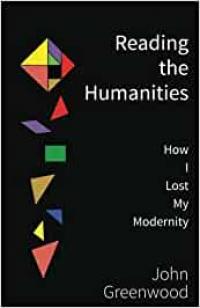 Link to Catalogue
Link to Catalogue
|
Greenwood, John. Reading the Humanities: How I Lost My Modernity. Oakville, ON: Rock's Mill Press, 2016. The modern revolution has been both a blessing and a curse. Its break with the past has liberated us from traditional thinking and brought a new excitement to politics, economics and science. But a marked discontent remains: anxiety, frustration, busyness, theoretical fog and spiritual exhaustion strain the modern psyche. A seemingly unreachable ideal hovers over every modern ambition. Reading the Humanities offers a fresh new perspective on the modern malaise by reinventing the lost habit of dialogue, examining the contrasting postures of modernity and tradition. Offering a virtual tour through the ‘Great Books,’ the argument reconsiders the relevance of traditional sources while focusing a critical lens on our contemporary predicament. Authors from Homer to Joyce, Machiavelli to Marx, Shakespeare to Shelley, Plato, Virgil, Kant, Hume, Austen, Eliot and Arendt, among others, are examined both for their sharply contrasting views and for their continuing modern relevance. A new vision emerges of what Socrates called the ‘examined life,’ the ‘good’ life, the only life worth living. New ideas about individual agency, purposeful action, moral striving and sacred intention arise out of debates forged over classical, Christian, Enlightenment and contemporary voices in literature and philosophy. The exciting result is a modern project revitalized by the energy that flows from the habit of engaging difference. [Source: publisher's website] |
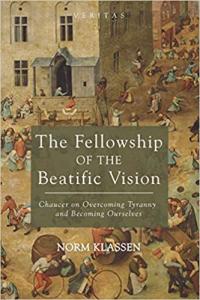 Link to Catalogue
Link to Catalogue
|
Klassen, Norm. The Fellowship of the Beatific Vision: Chaucer on Overcoming Tyranny and Becoming Ourselves. Eugene, OR: Cascade Books, 2016. In The Canterbury Tales, Geoffrey Chaucer asks a basic human question: How do we overcome tyranny? His answer goes to the heart of a revolutionary way of thinking about the very end of human existence and the nature of created being. His answer, declared performatively over the course of a symbolic pilgrimage, urges the view that humanity has an intrinsic need of grace in order to be itself. In portraying this outlook, Chaucer contributes to what has been called the "palaeo-Christian" understanding of creaturely freedom. Paradoxically, genuine freedom grows out of the dependency of all things upon God. In imaginatively inhabiting this view of reality, Chaucer aligns himself with that other great poet-theologian of the Middle Ages, Dante. Both are true Christian humanists. They recognize in art a fragile opportunity: not to reduce reality to a set of dogmatic propositions but to participate in an ever-deepening mystery. Chaucer effectively calls all would-be members of the pilgrim fellowship that is the church to behave as artists, interpretively responding to God in the finitude of their existence together. [Source: publisher's website] |
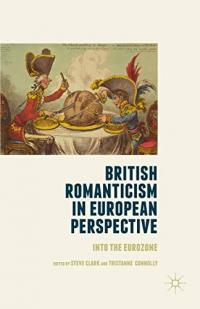 Link to Catalogue
Link to Catalogue
|
Clark, Steve, and Tristanne Connolly, eds. British Romanticism in European Perspective: Into the Eurozone. Houndsmills, UK: Pagrave Macmillan, 2015. What, and when, is British Romanticism, if seen not in island isolation but cosmopolitan integration with European Romantic literature, history and culture? The essays here range from poetry and the novel to science writing, philosophy, visual art, opera and melodrama; from France and Germany to Italy and Bosnia. [Source: publisher's website] |
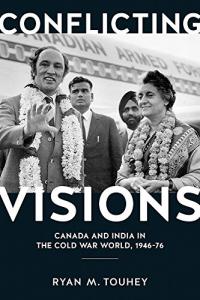 Link to Catalogue
Link to Catalogue
|
Touhey, Ryan. Conflicting Visions: Canada and India in the Cold War, 1946-76. Vacouver, BC: UBC Press, 2015. In 1974, India shocked the world by detonating a nuclear device. In the diplomatic controversy that ensued, the Canadian government expressed outrage that India had extracted plutonium from a Canadian reactor donated only for peaceful purposes. In the aftermath, relations between the two nations cooled considerably. As Conflicting Visions reveals, Canada and India’s relationship was turbulent long before the first bomb blast. From the time of India’s independence from Britain, Ottawa sought to build bridges between India and the West through dialogue and foreign aid. New Delhi, however, had a different vision for its future, and throughout the Cold War mistrust between the two nations deepened. These conflicting visions soured the relationship between the two governments long before India’s display of nuclear might. Ryan Touhey draws on the personal papers of diplomats and politicians; archival records from Canada, India, the United States, and Britain; and interviews with retired Canadian officials to trace the breakdown of this complicated bilateral relationship. In the process, he deepens our understanding of the history of Canadian foreign aid and international relations during the Cold War. As the first comprehensive history of Canadian diplomatic relations with India, this book will be indispensable for scholars and students of Canadian foreign relations and international history, particularly in South Asia; policy makers and members of the diplomatic corps; and the Indian diaspora community in Canada. [Source: publisher's website] |
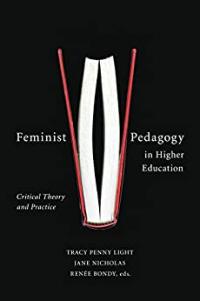 Link to Catalogue
Link to Catalogue
|
Penny Light, Tracy, Jane Nicholas, and Renée Bondy, eds. Feminist Pedagogy in Higher Education: Critical Theory and Practice. Waterloo, ON: Wilfrid Laurier University Press, 2015. In this new collection, contributors from a variety of disciplines provide a critical context for the relationship between feminist pedagogy and academic feminism by exploring the complex ways that critical perspectives can be brought into the classroom. This book discusses the processes employed to engage learners by challenging them to ask tough questions and craft complex answers, wrestle with timely problems and posit innovative solutions, and grapple with ethical dilemmas for which they seek just resolutions. Diverse experiences, interests, and perspectives—together with the various teaching and learning styles that participants bring to twenty-first-century universities—necessitate inventive and evolving pedagogical approaches, and these are explored from a critical perspective. The contributors collectively consider the implications of the theory/practice divide, which remains central within academic feminism’s role as both a site of social and gender justice and as a part of the academy, and map out some of the ways in which academic feminism is located within the academy today. [Source: publisher's website] |
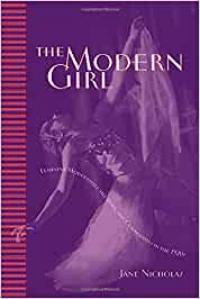 Link to Catalogue
Link to Catalogue
|
Nicholas, Jane. Modern Girl: Feminine Modernities, the Body, and Commodities in the 1920s. Toronto, ON: University of Toronto Press, 2015. With her short skirt, bobbed hair, and penchant for smoking, drinking, dancing, and jazz, the “Modern Girl” was a fixture of 1920s Canadian consumer culture. She appeared in art, film, fashion, and advertising, as well as on the streets of towns from coast to coast. In The Modern Girl, Jane Nicholas argues that this feminine image was central to the creation of what it meant to be modern and female in Canada. Using a wide range of visual and textual evidence, Nicholas illuminates both the frequent public debates about female appearance and the realities of feminine self-presentation. She argues that women played an active and thoughtful role in their embrace of modern consumer culture, even when it was at the risk of serious social, economic, and cultural penalties. The first book to fully examine the “Modern Girl”’s place in Canadian culture, The Modern Girl will be essential reading for all those interested in the history of gender, sexuality, and the body in the modern world. [Source: publisher's website] |
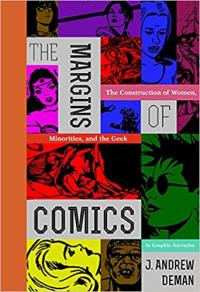 Link to Catalogue
Link to Catalogue
|
Deman, J. Andrew. The Margins of Comics. St. Catharines, ON: Nuada Press, 2015. From Author J. Andrew Deman a look at different groups in comics. What are the consequences for an art-form when it establishes century-long tradition of taking the low road when it comes to representations of women, racial minorities and geeks? More importantly, how can an art-form move beyond such a tradition? Comics have frequently relied upon Othering practices such as stereotype when representing minority characters. This tendency, in turn, contributes to the low cultural status of comics throughout the better part of the last century. In recent years, however, comics artists have cultivated revisioning techniques that challenge the use of Othering practices in comics. These efforts represent an important step in the push toward what is now known as the mics-as-literature movement. In essence, The Margins of Comics is a chronicle of how Othering lowered the cultural status of comics and how revisioning allowed a new generation of artists to carve a different path for an often maligned art-form. {Source: publisher's website] |
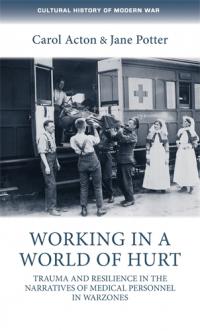 Link to Catalogue
Link to Catalogue
|
Acton, Carol, and Jane Potter. Working in a World of Hurt: Trauma and Resilience in the Narratives of Medical Personnel in Warzones. Manchester, UK: Manchester University Press, 2015. Working in a world of hurt fills a significant gap in the studies of the psychological trauma wrought by war. It focuses not on soldiers, but on the men and women who fought to save them in casualty clearing stations, hospitals and prison camps. The writings by doctors, nurses, ambulance drivers and other medical personnel reveal the spectrum of their responses that range from breakdown to resilience. Through a rich analysis of both published and unpublished personal from the First World War in the early twentieth century to Iraq in the early twenty-first, Acton and Potter put centre stage the letters, diaries, memoirs and weblogs that have chronicled physical and emotional suffering, many for the first time. Wide-ranging in scope, interdisciplinary in method, and written in a scholarly yet accessible style, Working in a world of hurt is essential reading for lecturers and students as well as the general reader. [Source: publisher's website] |
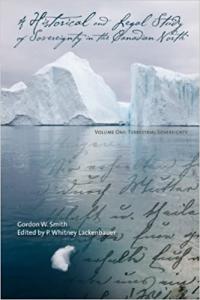 Link to Catalogue
Link to Catalogue
|
Smith, Gordon W. A Historical and Legal Study of Sovereignty in the Canadian North: Terrestrial Sovereignty, 1870-1939. Edited by P. Whitney Lackenbauer. Calgary, AB: University of Calgary Press, 2014. Gordon W. Smith, PhD, dedicated much of his life to researching Canada’s sovereignty in the Arctic. His 1952 dissertation from Columbia University, “The Historical and Legal Background of Canada’s Arctic Claims” remains a foundational work on the topic, as does his 1966 chapter “Sovereignty in the North: The Canadian Aspect of an International Problem” in R. St. J. Macdonald’s The Arctic Frontier. A Historical and Legal Study of Sovereignty in the Canadian North is the first in a project to edit and publish Smith’s unpublished opus—a manuscript on sovereignty and related Law of the Sea issues. Researched and written over three decades, this comprehensive and thoroughly documented study offers important insights into evolving understandings of Canada’s sovereignty from the original transfers of the northern territories to the young dominion through the start of the Second World War. With Arctic issues once again at the forefront of public debate, this invaluable resource —available to researchers outside of government for the first time—explains how Canada laid the historical and legal foundations to support its longstanding, well-established sovereignty over Arctic lands. [Source: publisher's website] |
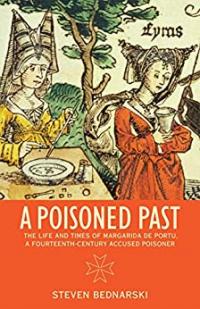 Link to Catalogue
Link to Catalogue
|
Bednarski, Steven. A Poisoned Past: The Life and Times of Margarida de Portu, a Fourteenth-Century Accused Poisoner. Toronto, ON: University of Toronto Press, 2014. This is the story of Margarida de Portu, a fourteenth-century French medieval woman accused of poisoning her husband to death. As Bednarski points out, the story is important not so much for what it tells us about Margarida but for how it illuminates a past world. Through the depositions and accusations made in court, the reader learns much about medieval women, female agency, kin networks, solidarity, sex, sickness, medicine, and law. Unlike most histories, this book does not remove the author from the analysis. Rather, it lays bare the working methods of the historian. Throughout his tale, Bednarski skillfully weaves a second narrative about how historians "do" history, highlighting the rewards and pitfalls of working with primary sources. The book opens with a chapter on microhistory as a genre and explains its strengths, weaknesses, and inherent risks. Next is a narrative of Margarida's criminal trial, followed by chapters on the civil suits and appeal and Margarida's eventual fate. The book features a rough copy of a court notary, a notorial act, and a sample of a criminal inquest record in the original Latin. A timeline of Margarida's life, list of characters, and two family trees provide useful information on key people in the story. A map of late medieval Manosque is also provided. [Source: publisher's website] |